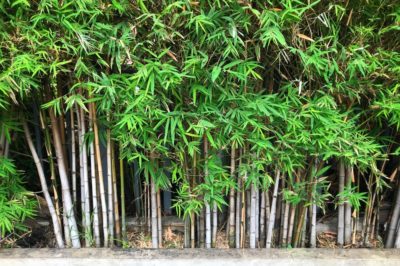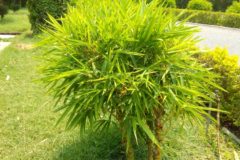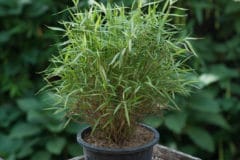What Kind of Plant is Bamboo?
It might seem like a strange concept when discussing a plant that can grow to 60 feet, but bamboo is a member of the grass family. Understanding that makes it easier to understand why – even though some bamboos look like trees – they need much the same kind of care and maintenance as your lawn. Anyone with Bermuda grass understands why bamboo needs rootpruning: both spread by rhizomes.
What Zones Does Bamboo Grow In?
There’s a bamboo for nearly any USDA zone. Some species of bamboo are native to hot, humid tropical locations. Others grow on cool mountain slopes. Although most bamboo species are native to Southeast Asia, bamboo is also found in America and Africa. A few are hardy to -20°F (-7°C). Some bamboo can grow in USDA Zone 4, although garden varieties are usually found in Zone 5 and up.
How Should I Choose Bamboo?
First, consider why you want to plant bamboo – a bamboo for a screen may not be suitable as an accent plant. Second, choose between running (very fast growth and may be invasive) or clumping (different growth pattern) bamboo. Third, consider sun exposure. Fourth, estimate how much time you can devote to care – running bamboo will take more effort on a regular basis.
Are There Bamboos I Shouldn’t Grow?
A bamboo with a high probability of invasiveness can quickly become a problem and in some states may be illegal. Be wary of these:
- Chimonobambusa quadrangularis Suow; Golden Square Stem.
- Phyllostachys aurea; Fishpole Bamboo, Golden Bamboo; illegal in New York and Connecticut.
- P. aureosulcata; Yellow Groove.
- P. rubromarginata; Red Margin Bamboo.
- P. vivax; Chinese Timber Bamboo.
- Semiarundinaria fastuosa Viridis; Green Temple Bamboo.
What Kind of Sun Exposure Does Bamboo Need?
Just like its grass relatives, bamboo grows better with adequate sunlight. Generally speaking, larger varieties of bamboo need more sunlight. Smaller bamboos, which grow near the ground under the upper story of taller plants, will be more shade tolerant. At a minimum, bamboo needs five hours of sun ; it prefers morning sun with afternoon shade. Check the requirements before you plant.
Will Bamboo Grow in Deep Shade?
The so-called Heavenly Bamboo (not a bamboo at all but Nandina domestica) is the only “bamboo” that will grow reasonably well in heavy shade. Most shade-tolerant bamboos can handle dappled shade. Choose green screen umbrella bamboo (Fargesia robusta “Pingwu”) or dwarf whitestripe bamboo (Pleioblastus fortunei). Other possibilities include dwarf greenstripe bamboo (Pleioblastus viridistriatus) and Kuma bamboo (Sasa veitchii).
What Soil is Best for Bamboo?
Bamboo generally prefers a soil on the acid side, with a pH of about 6.0. A soil test will indicate if your soil is too alkaline – add lime as necessary. Although many varieties of bamboo will grow in poor soil, they will grow better and be healthier in fertile garden soil. They do need good drainage to prevent root rot and to ensure oxygen in the soil.
How Can I Improve My Soil?
If your garden soil is poor – for example, it is primarily sand – add aged manure, well-rotted leaf mold and organic compost as amendments. Clay soil should receive sand, perlite or granite to promote drainage. Soil tests will indicate if your soil needs additional minerals like potassium or phosphorus. Other organic soil amendments include hardwood ashes, sea weed meal and kelp.
Why Should I Prune Bamboo?
Like any plant, bamboo may be overly thick in one area or grow crooked. Pruning opens up the plant to increase sun exposure and prevents branches from rubbing on one another. Bamboo that is densely packed is more susceptible to insect damage and mildew from poor air movement. Pruning also allows you to shape bamboo to improve its appearance or to create topiary shapes.
Should I Thin Bamboo?
Thinning is a form of pruning specifically directed at opening up a bamboo clump to improve air circulation. Like general pruning, it also improves sun exposure. Is is particularly important to thin running bamboo to help keep it under control. However, clumping bamboo also benefits from trimming as it tend to grow in thick stands. To thin, cut culms off at ground level.
How Should I Prune Bamboo?
Always prune in late summer or fall, after peak growth. Depending on the size and thickness of the plant, use loppers, sharp pruners or a saw. Always clean your tools prior to pruning and between plants to prevent spreading disease. Remember, a cut culm or branch will not grow back, so plan your cuts. Prune culms just above culm nodes and branches just above branch nodes.
Why Should I Rootprune Bamboo?
First, it is absolutely critical to rootprune running bamboo, because it sends out horizontal rhizomes from which grow multiple vertical culms. Running bamboos grow fast and many can become invasive without regular root pruning. Unpruned running bamboos have caused neighborhood feuds and taken over good land in many areas. However, clumping bamboos will also spread – just more slowly – and should also be rootpruned on a regular basis.
How Should I Rootprune Bamboo?
Since bamboo grows new rhizomes in summer and fall, rootpruning should occur after this growth period. Use a sharp, flat-bottomed shovel to rootprune bamboo. Drive the shovel straight down in the ground, severing the horizontal or vertical rhizomes of the bamboo. Repeat around the entire plant perimeter. Remove any of the cut-off pieces, which will otherwise sprout and grow more bamboo plants.
Do I Need a Trench Around Bamboo?
A trench is a helpful way to keep running bamboos under control. Since the rhizomes only grow horizontally, they will poke through the side of the trench, which makes them very easy to see and prune. Some gardeners plant bamboo in a raised bed and trench around the bed as additional insurance that any wandering rhizomes can be quickly dealt with.
Should I Use a Barrier for Bamboo?
Using a barrier is essentially like planting a bamboo in a pot. Barriers can be made of concrete, metal or heavy duty plastic. The barrier is usually placed just prior to planting the bamboo. Since bamboo doesn’t spread downward, the barrier only goes around the circumference. A barrier should be about two feet tall and placed so it has a two-inch lip above the ground.
Does Using a Barrier Mean Less Maintenance?
A barrier helps contain the spread of a bamboo plant, so you may not need to do as much rootpruning. However, a barrier confines the roots. Eventually the plant will become root-bound; some people place the barrier only on one side to prevent this. Barriers can also corrode or break, and the bamboo will quickly take advantage of even the smallest openings, so frequent inspections are necessary.
What Fertilizer is Best for Bamboo?
Bamboo grown in reasonably fertile garden soil often requires no fertilizer. Bamboo in pots, however, should be fertilized. Any fertilizer should be high in nitrogen; lawn fertilizer works well. Organic compost and manure are good choices. Mid to late spring is generally the best time to apply commercial organic fertilizer. Manure and compost are better applied in the fall so they can soak into the soil.
How Do I Water Bamboo?
Bamboo is one of those plants that likes water but doesn’t tolerate water-logged soil. Just as lawn grass in low areas where water puddles will develop diseases, bamboo will do the same. However, fast-draining soil can mean the plant needs frequent watering, especially in hot, windy areas. A soaker hose or drip irrigation can provide a way to ensure moist soil without too much water.
Does Bamboo Need to Be Divided?
If you really want more bamboo, you can divide the culms and plant them in new areas. However, most gardeners operate on the principle that they want to keep bamboo confined to a particular area. When gardeners rootprune, the cuttings are more likely to be burned than replanted. If you have a particularly choice specimen, you can replant rootprunings in the ground or pots.
Does Bamboo in Containers Need Different Care?
Bamboo in containers needs pretty much the same care as bamboo planted in the garden. However, it is even more important to avoid over-watering. Over-watering is the primary reason bamboo in containers dies. In cold climates, frost-sensitive bamboo may need to be moved inside in winter. Bamboo in containers will also need to be re-potted periodically as it will become root-bound.












